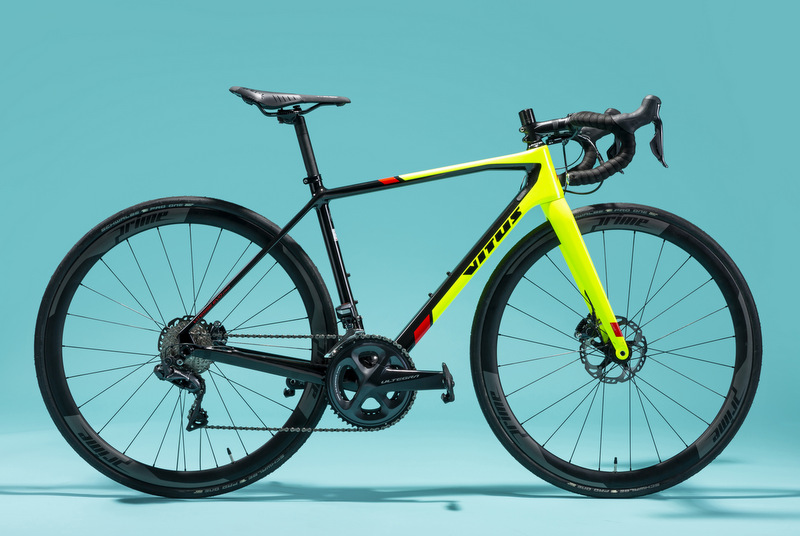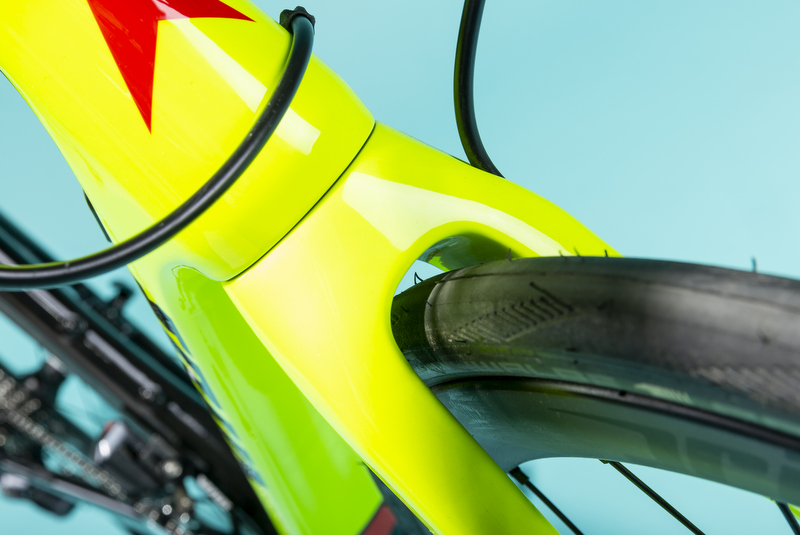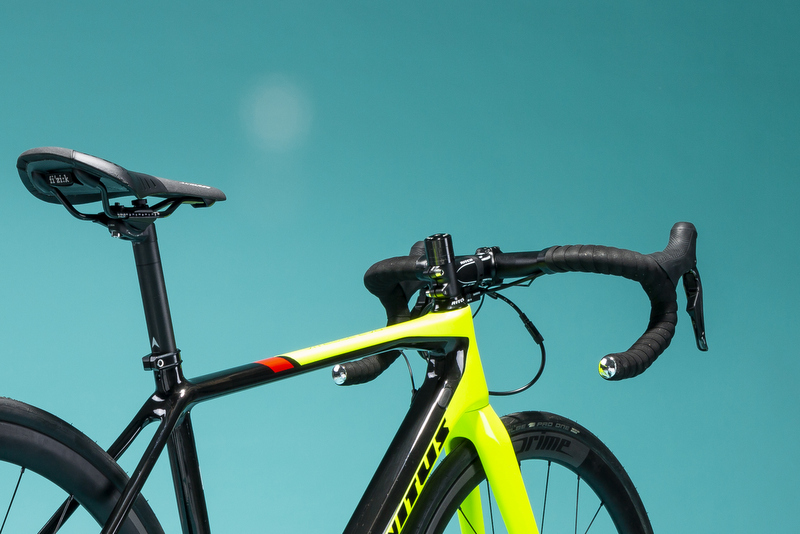Vitus Vitesse Evo CRI Disc Di2 road bike review
Setting out to create an 'all-round' race bike is a tough mission: has Vitus made a jack of all trades or a master of none?

Vitus Vitesse Evo CRI Disc Di2 road bike
A stiff and animated race bike with some quality spec to boot and a geometry that bends itself to the task without being neck-achingly aggressive. A few spec choices – the handlebars and gearing – seem at odds with the racing goal and the harsh frame does little to limit fatigue.
-
+
Top spec for the money
-
+
Stiff frame
-
-
Clattery over rough surfaces
You can trust Cycling Weekly.

The Vitus Vitesse has been built to be a very velocious velocipede.
Now we've established that we can all play at alliteration, the next thing to note is that the bike was raced by and developed alongside the now disbanded An-Post Chain Reaction Cycles Pro Conti team.
The goal was to create a true 'all-round' race bike that would be capable of everything from the "spring Classics, to the high mountains of France."
So it's a jack of all trades, which leads me to question: is it a master of none?
Available with rim or disc brakes, the Vitesse is the lightest bike on offer from Vitus: the size 52 we had on test weighed in at 7.68kg.
Whilst designers wanted to keep the weight down, power transfer couldn't be buried under the holy grail of weight shedding.
In a nod to optimising every stroke, Vitus has opted to use a BB 386 Evo, which it calls the widest and most efficient bottom bracket standard. The oversized BB is asymmetric, which means that the left chainstay can be widened for greater strength and stiffness.
The latest race content, interviews, features, reviews and expert buying guides, direct to your inbox!
Of course, with great stiffness can come great discomfort. In a bid to alleviate this, Vitus has used a 27.2mm carbon seatpost and kept the seatstays skinny to help disrupt road buzz on its way to meeting the rider at the derriere.

Vitus Vitesse Evo CRI Disc Di2 road bike
Tyres play a large role in comfort, and in this case Vitus has specced 25mm Schwalbe Ones; the frame allows for 28mm and if you choose to make the swap you'll get a further reduction in road buzz.
The carbon of choice is a high modulus T700, and cable routing is internal. Being a race bike, the geometry is designed for a rider with a need for speed.
The vital statistics for the 52cm in test are 376 (reach)/534 (stack) – that's a tad shorter than a Specialized Tarmac and a Cannondale SuperSix Evo, but only by 4-5mm – so nothing that couldn't be resolved by swapping the 100mm stem for a 110mm.
The drop is a bit shallower than the Tarmac, but greater than on the SuperSix by 2mm – so we're in road race territory.
I tested the bike with the stem slammed and it took a ride or two to adjust to the layout compared to my standard, but it felt pretty spot on once I'd made some changes to the finishing kit (handlebars, saddle).
The reach did feel quite a lot more compact than some of the more aggressive offerings on the market, which will be good news to some and bad news to others.
Expert handling is something Cycling Weekly has applauded this bike for in the past. However, behind the 40cm handlebars specced – standard for a unisex bike of this size – I felt like I was at the wheel of a tractor.

I also disliked the wide, flattened top of the bars and the shallowness of the drop, which in the descending position felt barely differentiated from being on the tops. Neither of these attributes goes hand-in-hand with the racing remit.
Handlebars are pretty exchangeable – so of course I swapped them for a 38cm of my own choice and the bike immediately came alive for me.
On smooth roads, it felt fast: planted to the tarmac, direct and animated.
After a busy summer of road and crit racing, my autumn training schedule is pretty much made up of gym sessions and easy spins, but I couldn't help but smash out a few sprints and power climb efforts.
The frame carries a notably positive drive which seemed to push me up the climbs, and tucked into my best attempt at an aero crouch, it felt speedy on the flat too.
What let it down were rough roads, where what had felt like a stunningly direct and natural ride was replaced with the tinny clatter of harsh carbon – even when riding at 80psi.
Sure, it's a race bike. I like a fast, stiff race bike as much as anyone but faced with a stretch of unmade tarmac in a road race, I don't want to feel like I've been transported to the rock gardens of Afan forest. Meeting a pothole I can't bunny hop, neither do I want to feel like I'm sailing into an abyss from which I may never exit.
Spend more on the frame and sacrifice some of the swanky spec and you can have stiffness and compliance in one package – a pairing this Vitus only offers one of.
The chassis is fitted with Prime Carbon RR38 disc wheels. Though these come with a respectable weight (789g front, 918g rear), it's possible that they offer more at the altar of aerodynamics than compliance, and they could explain some of the lack of road smoothing.
At this price point, the spec is Shimano Ultegra Di2 (largely R8070 with some R8050 and R8000 thrown in), with hydraulic disc brakes.
The gearing is a semi-compact 52/36 with an 11-30 cassette. Like the endurance-shaped handlebars, the wide-range cassette seems slightly dichotomous with the overall goal of the bike. I can't say I was moaning about it when spinning up the hills from my home 'in the valley', but it's not really a ratio I'd take to a race. Get an 11-28 or 11-25 on here to close those ratio gaps at the rear.
The specced saddle is a Fizik Antares R5, which is a preferred perch among many a male cyclist so a nice touch if you're in the majority.
Vitus Vitesse Evo Disc: value
With an RRP of £3,199.99, you're getting a pretty good deal from Vitus. At this price point, the majority of the big name brands will still give you Ultegra, but it won't be electronic and you'll not get the likes of carbon rims. Schwalbe One tyres aren't cheap and the Fizik saddle plus carbon seatpost are nice touches.
Michelle Arthurs-Brennan the Editor of Cycling Weekly website. An NCTJ qualified traditional journalist by trade, Michelle began her career working for local newspapers. She's worked within the cycling industry since 2012, and joined the Cycling Weekly team in 2017, having previously been Editor at Total Women's Cycling. Prior to welcoming her first daughter in 2022, Michelle raced on the road, track, and in time trials, and still rides as much as she can - albeit a fair proportion indoors, for now.
Michelle is on maternity leave from April 2025 until spring 2026.
